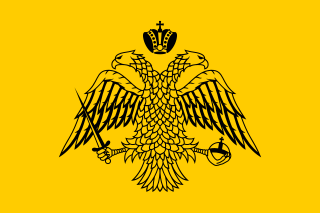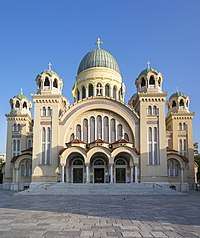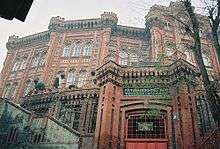Greek Orthodox Church
The name Greek Orthodox Church (Greek: Ἑλληνορθόδοξη Ἑκκλησία, Ellinorthódoxi Ekklisía, IPA: [elinorˈθoðoksi ekliˈsia]), or Greek Orthodoxy, is a term referring to the body of several Churches[2][3][4] within the larger communion of Eastern Orthodox Christianity, whose liturgy is or was traditionally conducted in Koine Greek,[5] the original language of the Septuagint and the New Testament.[6][7] Its history, traditions, and theology are rooted in the early Church Fathers and the culture of the Byzantine Empire. Greek Orthodox Christianity has also traditionally placed strong emphasis on and awarded high prestige to traditions of Eastern Orthodox monasticism and asceticism, with origins in Early Christianity in the Near East and in Byzantine Anatolia.
| Greek Orthodox Church | |
|---|---|
 | |
| Abbreviation | GOC |
| Classification | Eastern Orthodox Church |
| Scripture | Septuagint, New Testament |
| Theology | Eastern Orthodox theology |
| Polity | Episcopal |
| Primate | The Patriarchs of Constantinople, Alexandria, Antioch and Jerusalem, and the Archbishops of Athens, Cyprus, Albania and Mount Sinai |
| Language | Koine Greek, Katharevousa,[1] Arabic, and English, with other local languages used in the diaspora |
| Liturgy | Byzantine Rite |
| Headquarters | Various, but Constantinople is held in special regard |
| Territory | Eastern Mediterranean and Greek diaspora |
| Founder | Apostle Andrew |
| Recognition | Orthodox |
| Separations | True Orthodoxy (Greek Old Calendarism) (1920s) |
| Members | 23–25 million (about 40% of whom are in Greece) |
Historically, the term "Greek Orthodox" has been used to describe all Eastern Orthodox Churches in general, since "Greek" in "Greek Orthodox" can refer to the heritage of the Byzantine Empire.[8][9][10] During the first eight centuries of Christian history, most major intellectual, cultural, and social developments in the Christian Church took place within the Empire or in the sphere of its influence,[10][11][12] where the Greek language was widely spoken and used for most theological writings. Over time, most parts of the liturgy, traditions, and practices of the church of Constantinople were adopted by all, and these still provide the basic patterns of contemporary Orthodoxy.[13][14][15] Thus, the Eastern Church came to be called "Greek" Orthodox in the same way that the Western Church is called "Roman" Catholic. However, the appellation "Greek" was abandoned by the Slavic and other Eastern Orthodox churches in connection with their peoples' national awakenings, from as early as the 10th century A.D.[16][17][18] Thus, in the early 21st century, generally only those churches that are most closely tied to Greek or Byzantine culture are called "Greek Orthodox".
Overview
The Greek Orthodox churches are descended from churches which the Apostles founded in the Balkans and the Middle East during the first century A.D.,[19][20][21][22][23][24][25] and they maintain many traditions practised in the ancient Church.[25] Orthodox Churches, unlike the Catholic Church, have no single Supreme Pontiff, or Bishop (see also: Pontifex maximus), and hold the belief that Christ is the head of the Church. However, they are each governed by a committee of Bishops, called the Holy Synod, with one central Bishop holding the honorary title of "first among equals".
Greek Orthodox Churches are united in communion with each other, as well as with the other Eastern Orthodox Churches. The Orthodox hold a common doctrine and a common form of worship, and they see themselves not as separate Churches but as administrative units of one single Church. They are notable for their extensive tradition of iconography (see also: Byzantine art), for their veneration of the Mother of God and the Saints, and for their use of the Divine Liturgy on Sundays, which is a standardized worship service dating back to the fourth century A.D. in its current form. The most commonly used Divine Liturgy of the Orthodox Church was written by Saint John Chrysostom (347–407 A.D.). Others are attributed to St. Basil the Great, St. James, the Brother of God and St. Gregory the Dialogist.
The current territory of the Greek Orthodox Churches more or less covers the areas in the Balkans, Anatolia, and the Eastern Mediterranean that used to be a part of the Byzantine Empire. The majority of Greek Orthodox Christians live within Greece and elsewhere in the southern Balkans including Albania, but also in Jordan, the Palestinian territories, Iraq, Syria, Lebanon, Cyprus, Anatolia, European Turkey, and the South Caucasus. In addition, due to the large Greek diaspora, there are many Greek Orthodox Christians who live in North America and Australia. Orthodox Christians in Finland, who compose about 1% of the population, are also under the jurisdiction of a Greek Orthodox Church (the Ecumenical Patriarchate).
There are also many Greek Orthodox Christians, with origins dating back to the Byzantine and Ottoman periods, who are of Arabic-speaking or mixed Greek and Arabic-speaking ancestry and live in southern Turkey, Israel, Palestine, Iraq, Syria, Lebanon, Jordan, and Egypt. They attend churches which conduct their services in Arabic, the common language of most Greek Orthodox believers in the Levant, while at the same time maintaining elements of the Byzantine Greek cultural tradition.
Ethnic Greeks in Russia and Greeks in Ukraine, as well as Pontic Greeks and Caucasus Greeks from the former Russian Transcaucasus, often consider themselves both Greek Orthodox and Russian Orthodox, which is consistent with the Orthodox faith (since Orthodoxy is the same across ethnic boundaries). Thus, they may attend services held in Old Russian and Old Church Slavonic, without this in any way undermining their Orthodox faith or distinct Greek ethnic identity. Over the centuries, these Pontic Greek-speaking Greek Orthodox communities have mixed through intermarriage in varying degrees with ethnic Russians and other Orthodox Christians from mainly Southern Russia, where most of them settled between the Middle Ages and early 19th century.
Churches

The churches where the Greek Orthodox term is applicable are:
- The four ancient Patriarchates:
- The Ecumenical Patriarchate of Constantinople,[26] headed by the Ecumenical Patriarch of Constantinople, who is also the "first among equals" of the Eastern Orthodox Communion
- The Greek Orthodox Church of Alexandria[31]
- The Greek Orthodox Church of Antioch[32]
- The Greek Orthodox Church of Jerusalem[33]
- The autonomous Church of Mount Sinai[34]
- Three autocephalous churches:
- The Church of Greece[35]
- The Church of Cyprus[36][37][38]
- The Albanian Orthodox Church[39] also known as "Greek Orthodox Church of Albania" or "Church of Albania"[40][41] led since the collapse of the former Stalinist régime by Archbishop Anastasios, a Greek national. The Church conducts its liturgy in Koine Greek in the areas of Albania populated by the ethnic Greek minority, alongside the use of Albanian throughout the country.

- Holy Trinity Greek Orthodox Church, Vienna, designed by Theophil Hansen (1856)
 The building (1881) of the Phanar Greek Orthodox College (Phanari), established in 1454
The building (1881) of the Phanar Greek Orthodox College (Phanari), established in 1454
See also
|
|
References
- Argyropoulou, Christina (2015): Γλώσσα και εξουσία μέσα από ποικίλα κείμενα στην καθαρεύουσα και τη δημοτική μορφή της ελληνικής γλώσσας. Έρκυνα: Επιθεώρηση Εκπαιδευτικών 7: 52–69.
- Demetrios J. Constantelos, Understanding the Greek Orthodox Church, Holy Cross Orthodox Press 3rd edition (March 28, 2005)
- L. Rushton, Doves and Magpies: Village Women in the Greek Orthodox Church Women's religious experience, Croom Helm, 1983
- Paul Yuzyk, The Ukrainian Greek Orthodox Church of Canada, 1918–1951, University of Ottawa Press, 1981
- Demetrios J. Constantelos, The Greek Orthodox Church: faith, history, and practice, Seabury Press, 1967
- Daniel B. Wallace: Greek Grammar Beyond the Basics: An Exegetical Syntax of the New Testament, page 12,. Zondervan, 1997.
- Robert H. Stein: The method and message of Jesus' teachings, page 4,. Westminster John Knox Press, 1994.
- Boyd, Kelly (August 8, 1999). "Encyclopedia of Historians and Historical Writing". Taylor & Francis – via Google Books.
- Edwin Pears, The Destruction of the Greek Empire and the Story of the Capture of Constantinople by the Turks, Haskell House, 1968
- Millar, Fergus (2006). A Greek Roman Empire : Power and Belief under Theodosius II (408–450). University of California Press. p. 279 pages. ISBN 0-520-24703-5.
- Tanner, Norman P. The Councils of the Church, ISBN 0-8245-1904-3
- The Byzantine legacy in the Orthodox Church by John Meyendorff – 1982
- Hugh Wybrew, The Orthodox Liturgy: The Development of the Eucharistic Liturgy in the Byzantine Rite – 1990
- The Christian Churches of the East, Vol. II: Churches Not in Communion with Rome, by Donald Attwater – 1962
- J Meyendorff, Byzantine Theology: Historical Trends and Doctrinal Themes (1987)
- Joan Mervyn Hussey, The Orthodox Church in the Byzantine Empire, 1990
- Vlasto, A. P. (1970). The Entry of the Slavs into Christendom: An Introduction to the Medieval History of the Slavs. Cambridge: Cambridge University Press. ISBN 0521074592. OCLC 637411069.
- Pantev, Andrey Lazarov (2000). Българска история в европейски контекст (in Bulgarian). IK "Khristo Botev". ISBN 9544456708. OCLC 45153811.
- Janet Saltzman Chafetz; Helen Rose Ebaugh (18 October 2000). Religion and the New Immigrants: Continuities and Adaptations in Immigrant Congregations. AltaMira Press. p. 155. ISBN 978-0-7591-1712-9. Retrieved 2 September 2013.
The distinctive characteristics of the Greek Orthodox Church are its sense of continuity with the ancient Church of Christ and the Apostles and its changelessness. The Orthodox church traces its existence, through the ordination of Bishops, directly back to the Apostles and through them to Jesus.
- Sally Bruyneel; Alan G. Padgett (2003). Introducing Christianity. Orbis Books. p. 7. ISBN 978-1-60833-134-5. Retrieved 2 September 2013.
The Eastern Orthodox and the Roman Catholic Churches are the oldest with roots going back to the earliest Christian groups.
- Benjamin Jerome Hubbard; John T. Hatfield; James A. Santucci (2007). An Educator's Classroom Guide to America's Religious Beliefs and Practices. Libraries Unlimited. p. 63. ISBN 978-1-59158-409-4. Retrieved 2 September 2013.
The Orthodox Church traces its origins to the churches founded by the apostles in the Middle East and the Balkans in the first century.
- Robert L. Plummer (6 March 2012). Journeys of Faith: Evangelicalism, Eastern Orthodoxy, Catholicism and Anglicanism. Zondervan. p. 128. ISBN 978-0-310-41671-5. Retrieved 2 September 2013.
Catholicism holds that if a Church claims to be Christian, then it must be able to show that its leaders-its bishops and its presbyters (or priests)- are successors of the apostles. That is why the Catholic Church accepts Eastern Orthodox ordinations and sacraments as valid, even though Eastern Orthodoxy is not in full communion with Rome.
- William A. Dyrness; Veli-Matti Kärkkäinen (25 September 2009). Global Dictionary of Theology: A Resource for the Worldwide Church. InterVarsity Press. p. 244. ISBN 978-0-8308-7811-6. Retrieved 2 September 2013.
This connection is apparent through the historical succession of bishops of churches in a particular geographic locale and by fidelity to the teachings of the apostles (cf. Acts 2:42) and life as it developed in the patristic tradition and was articulated by the seven ecumenical councils.
- Heidi Campbell (22 March 2010). When Religion Meets New Media. Routledge. p. 13. ISBN 978-0-203-69537-1. Retrieved 2 September 2013.
There are three branches within Christianity: Catholic, Eastern Orthodox, and Protestant. ... The Christian church draws its lineage and roots from the time of Jesus Christ and the apostles in CE 25–30 and the birth of the Church at Pentecost in ...
- Wendy Doniger (January 1999). Merriam-Webster's Encyclopedia of World Religions. Merriam-Webster. p. 309. ISBN 978-0-87779-044-0. Retrieved 2 September 2013.
EASTERN ORTHODOXY, one of the major branches of CHRISTIANITY, characterized by its continuity with the apostolic church, its liturgy, and its territorial churches.
- "Ecumenical Patriarchate". Retrieved 2009-03-09.
- "Archdiocese of Thyateira and Great Britain – Home". Retrieved 2009-03-11.
- "The Holy Orthodox Archdiocese of Italy and Malta". Archived from the original on 2012-02-26. Retrieved 2009-03-11.
- The Greek Orthodox Archdiocese of America should not be confused with the Orthodox Church in America, whose autocephaly – granted by the Russian Orthodox Church – is not recognized by the Ecumenical Patriarchate of Constantinople and many other churches of the Eastern Orthodox Communion.
- "Greek Orthodox Archdiocese of Australia". Retrieved 2010-01-14.
- "The official web site of Greek Orthodox Patriarchate of Alexandria and All Africa". Retrieved 2009-03-09.
- "Greek Orthodox Patriarchate of Antioch and All the East". Retrieved 2019-04-03.
- "Jerusalem Patriarchate". Archived from the original on 2012-04-18. Retrieved 2009-03-09.
- "The Holy Monastery of the God-trodden Mount Sinai, Saint Catherine's Monastery". Archived from the original on 2009-03-02. Retrieved 2009-03-09.
- "Ecclesia – The Web Site of the Church of Greece". Retrieved 2009-03-09.
- "Church of Cyprus" (in Greek). Retrieved 2009-03-09.
- "About Cyprus – Towns and Population". Government Web Portal – Areas of Interest. Government of Cyprus. Retrieved 19 January 2010.
- "Cyprus". The World Factbook. Central Intelligence Agency. Retrieved 19 January 2010.
- Roudometof, Victor (2002). Collective memory, national identity, and ethnic conflict. Greenwood Press. p. 179.
the only remaining issues between the two sides concern the extent to which minority members should have equal rights with the rest of the Albanian citizens as well as issues of property and ecclesiastical autonomy for the Greek Orthodox Church of Albania.
- Thornberry, Patrick (1987). Minorities and human rights law (1. publ. ed.). London: Minority Rights Group. p. 36. ISBN 9780946690480.
- "Albanian church attack 'act of religious hatred'". WorldWide Religious News. Retrieved 12 June 2012.
Further reading
- Aderny, Walter F. The Greek and Eastern Churches (1908) online
- Constantelos, Demetrios J. Understanding the Greek Orthodox church: its faith, history, and practice (Seabury Press, 19820
- Fortesque, Adrian. The Orthodox Eastern Church (1929)
- Hussey, Joan Mervyn. The orthodox church in the Byzantine empire (Oxford University Press, 2010) online
- Kephala, Euphrosyne. The Church of the Greek People Past and Present (1930)
- Latourette, Kenneth Scott. ' Christianity in a Revolutionary Age, II: The Nineteenth Century in Europe: The Protestant and Eastern Churches. (1959) 2: 479-484; Christianity in a Revolutionary Age, IV: The Twentieth Century in Europe: The Roman Catholic, Protestant, and Eastern Churches (1958)
- McGuckin, John Anthony (ed.). The Encyclopedia of Eastern Orthodox Christianity. 2 vols. (Wiley-Blackwell, 2011).
External links
